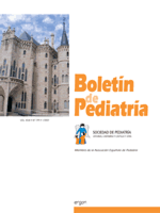Ingestión de cáusticos: revisión de la casuística de un hospital de tercer nivel
P. Prieto Matos , D. Martín Hernández , A. Grande Benito , J. de Manueles Jiménez , Á. Gimeno Díaz de Atauri , C. Criado Muriel
Bol. Pediatr. 2007; 47 (199): 55 - 61
Objetivos: analizar las características clínicas, epidemiológicas y los factores que pueden predecir lesión esofágica en la población infantil que ingresó en nuestro hospital por ingestión de cáusticos. Material y métodos: se realiza un estudio retrospectivo de los pacientes que requirieron ingreso por ingestión cáustica en los últimos 6 años. Se recogen distintas variables de la historia clínica entre las que destacamos, edad, sexo, tipo de cáustico, pH del líquido, sintomatología, tiempo de evolución y realización de la endoscopia. Resultados: desde el año 2000 hasta el tercer trimestre del 2006 fueron ingresados en nuestro Hospital 35 niños con la sospecha de haber ingerido una sustancia cáustica. De ellos 19 eran varones y 16 eran mujeres. La edad media fue de 2,6 años. Diez de los pacientes venían derivados de hospitales de otras provincias. Los cáusticos ingeridos fueron lejía (40,0%), amoniaco (17,1%), sosa (11,4%) y lavavajillas industrial (11,4%). El 42,9% de los casos los familiares realizaron procedimientos que pueden agravar la lesión. Los síntomas más frecuentes fueron vómitos (11 pacientes), heridas en los labios (8 pacientes), lesiones en la mucosa geniana (9 pacientes), quemaduras en la lengua (12 pacientes). Se indicó la endoscopia en 23 pacientes, que se llevó a cabo a las 31,5 horas de media tras la ingestión. En el 26,3% de las endoscopias se objetivó lesión esofágica (tipo 2a, 10,5% y tipo 2b, 15,8%). Los cáusticos más agresivos fueron la sosa, el amoniaco, y el lavavajillas industrial. Se observa una tendencia a encontrar relación entre el número de síntomas presentes y la probabilidad de lesión endoscópica. Conclusiones: la lejía es el agente cáustico más implicado en este tipo de accidente. La sosa, el amoniaco y el lavavajillas industrial son los líquidos más peligrosos. Los familiares todavía siguen realizando procedimientos inadecuados tras la ingestión. El mejor tratamiento es una buena prevención. Abstract Objectives: analyze the clinical, epidemiological characteristics and the factors that may predict esophageal injuries in the child population admitted to our hospital due to intake of caustics. Material and methods: a retrospective study was done of the patients who required admission due to caustic intake in the last six years. Different variables were collected from the clinical history, the following standing out among them: age, gender, type of caustics, pH of the liquid, symptoms, evolution time and conduction of endoscopy. Results: since the year 2000 until the third quarter of 2006, 35 children were admitted to our hospital with the suspicion of having ingested a caustic substance. Of them,19 were male and 16 female. Mean age was 2.6 years. Ten of the patients had been referred from hospitals of other provinces. The caustics ingested were bleach (40.0%), ammonium (17.1%), soda (11.4%) and industrial dishwasher soap (11.4%). In 42.9% of the cases, the families rejected procedures that could worsen the injury. The most frequent symptoms were vomiting (11 patients), lip wounds (8 patients), genian mucosal lesions (9 patients), burns under tongue (12 patients). Endoscopy was indicated in 23 patients, that was carried out at a mean of 31.5 hours after intake. In 26,3 of the endoscopes, esophageal injuries were observed (type 2a 10.5% and type 2b 15.8%). The most aggressive caustics were soda, ammonium and industrial dishwashing soap. Atendency was observed to find a relationship between the number of symptoms present and the likelihood of an endoscopic lesion. Conclusions: bleach is the caustic agent most involved in this type of accident. Soda, ammonium and industrial dishwashing soap are the most dangerous liquids. Family members are continuing to perform inadequate procedures after intake. The best treatment is a good preventive one.
\N
\N
Artículo completo (PDF) (84 kb.)
- Cirugía
